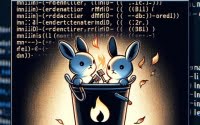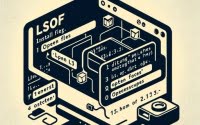The Various Use Cases of the ‘clear’ Command in Linux

Ever felt like your Linux terminal is a cluttered mess? You’re not alone. Many users find themselves lost in the sea of text that can accumulate in the terminal. But there’s a simple command that can help you regain control.
Think of the ‘clear’ command in Linux as a broom, sweeping away all the clutter and giving your terminal a fresh, clean look. It’s a simple yet powerful tool that can make your terminal experience much more manageable.
In this guide, we’ll walk you through the process of using the ‘clear’ command in Linux, from the basics to more advanced techniques. We’ll cover everything from the simple usage of ‘clear’ to clear your terminal, to more advanced techniques like clearing the terminal buffer, to alternative methods and common issues you might encounter.
So, let’s dive in and start mastering the ‘clear’ command in Linux!
TL;DR: How Do I Clear the Terminal in Linux?
To clear the terminal in Linux, simply type the
'clear'command and press enter. This command will clear all the content in your terminal, giving you a fresh, clean slate.
Here’s a simple example:
$ clear
After running this command, you’ll find that all previous commands and outputs in your terminal have been cleared away. It’s like starting with a brand new terminal window.
But the ‘clear’ command has more to offer than just this basic usage. Continue reading for more detailed information and advanced usage scenarios.
Table of Contents
Clear Linux Command: A Beginner’s Guide
The ‘clear’ command in Linux is a powerful tool that can help you maintain a clean and manageable terminal environment. At its most basic level, it’s incredibly simple to use.
The ‘clear’ command works by sending a special character to the terminal that tells it to clear all visible text. This command doesn’t actually delete any text or commands; it merely hides them from view, allowing you to start with a clean slate.
Here’s a basic example of how to use the ‘clear’ command:
$ echo 'Before clear command'
$ clear
$ echo 'After clear command'
# Output:
# Before clear command
# After clear command
In the above example, the first command echo 'Before clear command' prints the text ‘Before clear command’ to the terminal. The clear command is then used to clear the terminal. Finally, the echo 'After clear command' prints the text ‘After clear command’ to the terminal. The output you see is only the text ‘After clear command’ because the ‘clear’ command has cleared everything else.
The primary benefit of the ‘clear’ command is its simplicity and effectiveness. It’s easy to remember and use, and it does its job well. However, it’s important to note that the ‘clear’ command only clears the visible text in the terminal. Any text that has been scrolled up and out of view is not affected by the ‘clear’ command.
Unleashing the Power of the Clear Command
As you become more comfortable with the basic use of the ‘clear’ command, you might start to wonder what else this handy command can do. The truth is, the ‘clear’ command is more versatile than it might seem at first glance. It can also handle more complex tasks, such as clearing the terminal buffer.
Before we dive into these advanced uses, let’s familiarize ourselves with some command-line arguments that can modify the behavior of the ‘clear’ command. Here’s a quick reference table:
| Argument | Description | Example |
|---|---|---|
-T | Specifies the type of terminal to clear. | clear -T xterm |
-V | Displays version information. | clear -V |
-x | Do not try to clear scrollback. | clear -x |
-help | Displays help information. | clear --help |
Now that we’ve covered that, let’s delve into these features in more detail.
Clearing the Terminal Buffer
One of the more advanced uses of the ‘clear’ command is to clear the terminal buffer. This is useful when you want to completely wipe the terminal clean, including any text that has been scrolled out of view.
Here’s how you can do it:
$ printf '\033c'
This command uses the printf command to send a special escape sequence (\033c) to the terminal. This escape sequence tells the terminal to clear both the screen and the buffer.
After running this command, you’ll find that not only is the visible text cleared, but also the buffer. That means if you scroll up, you won’t see any previous commands or outputs.
This can be very useful in certain situations where you want to ensure that no residual data remains in the terminal. However, use it with caution, as once the buffer is cleared, there is no way to recover the cleared data.
Using Clear with Terminal Type
Sometimes, you might need to clear the terminal of a specific type. The ‘clear’ command allows you to do this with the -T argument. For example:
$ clear -T xterm
This command tells ‘clear’ to clear the terminal as if it’s an ‘xterm’ terminal. This can be useful if you’re scripting and need to clear a terminal of a specific type.
In conclusion, while the ‘clear’ command in Linux is simple to use, it also offers more advanced features that can give you greater control over your terminal environment. By understanding and utilizing these features, you can make your terminal experience even more efficient and enjoyable.
Exploring Alternatives to the Clear Command
While the ‘clear’ command is a versatile and powerful tool for maintaining a clean terminal environment, it’s not the only tool at your disposal. There are other methods for achieving the same result, each with its own set of benefits and drawbacks. Let’s explore some of these alternative approaches.
The ‘Reset’ Command
The ‘reset’ command is a more drastic alternative to the ‘clear’ command. While ‘clear’ simply hides the text from view, ‘reset’ actually removes the text from the terminal buffer. This means that after using ‘reset’, you won’t be able to scroll back to see previous commands or outputs.
Here’s how you can use the ‘reset’ command:
$ echo 'Before reset command'
$ reset
$ echo 'After reset command'
# Output:
# Before reset command
# After reset command
In the above example, after running the ‘reset’ command, you’ll find that not only is the visible text cleared, but also the buffer. That means if you scroll up, you won’t see any previous commands or outputs, not even the ‘Before reset command’ text.
The advantage of ‘reset’ is its thoroughness. It’s a surefire way to clear your terminal completely. However, the downside is that it’s irreversible. Once you’ve used ‘reset’, there’s no way to recover the cleared data.
Keyboard Shortcuts
There are also keyboard shortcuts that can clear your terminal. These can be faster and more convenient than typing out a command, especially if you find yourself needing to clear your terminal frequently.
For example, in most terminal emulators, you can use Ctrl + L to clear the terminal. This is essentially equivalent to using the ‘clear’ command.
Another useful shortcut is Ctrl + U. This clears the line from the cursor position to the beginning of the line, which can be handy if you’ve made a mistake while typing a command and want to start over.
To demonstrate, try typing a command but don’t press enter. Instead, press Ctrl + U. You’ll see that the line is instantly cleared.
$ echo 'This is a test' # Don't press enter, press Ctrl + U instead
# Output:
# $
In the end, the best method for clearing your terminal depends on your specific needs and preferences. Whether you prefer the simplicity of ‘clear’, the thoroughness of ‘reset’, or the convenience of keyboard shortcuts, there’s a solution that’s right for you.
Troubleshooting the Clear Command
The ‘clear’ command in Linux is generally quite reliable, but like any tool, it can sometimes behave unexpectedly. Let’s take a look at some common issues you might encounter when using the ‘clear’ command, along with their solutions.
Issue: The ‘clear’ Command Doesn’t Clear the Buffer
As we’ve discussed, the ‘clear’ command doesn’t actually clear the terminal buffer. It only clears the visible text in the terminal. This means that if you scroll up after using the ‘clear’ command, you’ll still see your previous commands and outputs.
If you want to clear the buffer as well, you can use the ‘reset’ command or the printf '\033c' command, as we detailed in the advanced usage section.
Issue: The ‘clear’ Command Isn’t Recognized
Sometimes, you might get an error message saying that the ‘clear’ command isn’t recognized. This usually happens if you’re using a shell that doesn’t have the ‘clear’ command, or if the ‘clear’ command isn’t in your PATH.
In such cases, you can use an alternative command to clear the terminal. For example, you can use the tput clear command, which should work in most shells:
$ echo 'Before tput clear'
$ tput clear
$ echo 'After tput clear'
# Output:
# Before tput clear
# After tput clear
In the above example, the tput clear command works similarly to the ‘clear’ command, clearing the visible text in the terminal.
Best Practices When Using the Clear Command
When using the ‘clear’ command, there are a few best practices to keep in mind:
- Use it sparingly. While it can be tempting to constantly clear your terminal to keep it clean, doing so can make it harder to refer back to previous commands or outputs. Instead, try to use the ‘clear’ command strategically, such as when you’re about to start a new task.
Be aware of the limitations. Remember that the ‘clear’ command doesn’t clear the terminal buffer. If you need to clear the buffer, consider using the ‘reset’ command or the
printf '\033c'command.Learn the shortcuts. If you find yourself using the ‘clear’ command frequently, it can be faster and more convenient to use a keyboard shortcut like
Ctrl + L.
By keeping these considerations and tips in mind, you can use the ‘clear’ command effectively and efficiently, making your Linux terminal experience smoother and more enjoyable.
Understanding the Linux Terminal
Before we delve deeper into the ‘clear’ command, it’s important to understand the environment in which it operates — the Linux terminal. The terminal, also known as the command line or shell, is a powerful tool that allows you to interact directly with your Linux system.
How Does the Linux Terminal Work?
The Linux terminal operates on a command-line interface (CLI), a text-based interface where you input commands to perform operations on your system. This is in contrast to a graphical user interface (GUI), which allows you to perform operations with visual interactions like clicking and dragging.
When you input a command into the terminal, it’s interpreted by the shell, a program that reads and executes the command. The shell then sends the command to the operating system to carry out the operation.
$ echo 'This is a command'
# Output:
# This is a command
In the above example, ‘echo’ is a command that tells the shell to print the following text to the terminal. The shell interprets this command and sends it to the operating system, which then prints ‘This is a command’ to the terminal.
The Importance of the ‘Clear’ Command
Now that we understand how the Linux terminal works, we can better appreciate the role of the ‘clear’ command. As you interact with the terminal, you’ll often find yourself running numerous commands, resulting in a cluttered terminal. This is where the ‘clear’ command comes in handy.
The ‘clear’ command interacts directly with the terminal interface, sending a special character that instructs the terminal to clear all visible text. It’s a simple yet effective way to manage your terminal environment and keep it clean and organized.
In the next sections, we’ll explore more advanced and alternative uses of the ‘clear’ command, further enhancing your ability to maintain a clean and efficient terminal environment.
Beyond the Clear Command: Mastering Terminal Management
The ‘clear’ command is an essential tool for maintaining a clean and organized terminal environment. But it’s just one piece of the puzzle. To truly master terminal management in Linux, it’s important to explore related commands and concepts.
Exploring Related Commands
There are many other commands that can help you manage your terminal environment. For example, the ‘history’ command allows you to view your command history, while the ‘alias’ command lets you create shortcuts for frequently used commands. By understanding and utilizing these commands, you can further enhance your terminal experience.
Here’s an example of how you can use the ‘history’ command:
$ history
# Output:
# 1 echo 'This is a command'
# 2 clear
# 3 echo 'After clear command'
# 4 history
In the above example, the ‘history’ command lists all the commands you’ve previously run in the terminal. This can be useful for recalling previous commands or identifying patterns in your command usage.
The Art of Terminal Management
Mastering terminal management isn’t just about knowing the right commands. It’s also about developing good habits and understanding the underlying principles. For example, it’s important to keep your terminal organized and avoid clutter. This not only makes it easier to navigate your terminal, but also reduces cognitive load and makes it easier to focus on your tasks.
Further Resources for Terminal Mastery
To continue your journey towards mastering terminal management, check out these resources:
- The Linux Command Line: A Complete Introduction – This book provides a comprehensive introduction to the Linux command line, including terminal management.
Linux Command Library – An online resource that provides a library of Linux commands, including their usage and examples.
“clear” Command in Linux with Examples: GeeksforGeeks offers a comprehensive article on the “clear” command in Linux, providing examples and explanations of its usage.
Remember, mastering the terminal takes time and practice. But with the right resources and a bit of persistence, you’ll be a terminal pro in no time.
Wrapping Up: Mastering the Clear Command in Linux
In this comprehensive guide, we’ve embarked on a journey to understand the ‘clear’ command in Linux, a simple yet powerful tool for maintaining a clean and organized terminal environment.
We started with the basics, learning how to use the ‘clear’ command to clear the visible text in the terminal. We then dove into more advanced usage, such as clearing the terminal buffer and specifying the terminal type. Along the way, we tackled common issues you might encounter when using the ‘clear’ command and provided solutions to help you overcome these challenges.
We also explored alternative approaches to clearing the terminal, such as the ‘reset’ command and keyboard shortcuts. Each method has its own set of advantages and disadvantages, giving you a range of options to choose from based on your specific needs and preferences.
Here’s a quick comparison of these methods:
| Method | Pros | Cons |
|---|---|---|
| Clear Command | Simple and effective, doesn’t clear buffer | Only clears visible text |
| Reset Command | Clears both visible text and buffer | Irreversible |
| Keyboard Shortcuts | Fast and convenient | Might not be available in all shells |
Whether you’re just starting out with the ‘clear’ command or you’re looking to level up your terminal management skills, we hope this guide has given you a deeper understanding of the ‘clear’ command and its capabilities.
Mastering the ‘clear’ command in Linux can greatly enhance your terminal experience, making it more efficient and enjoyable. Now, you’re well equipped to keep your terminal clean and organized. Happy coding!


